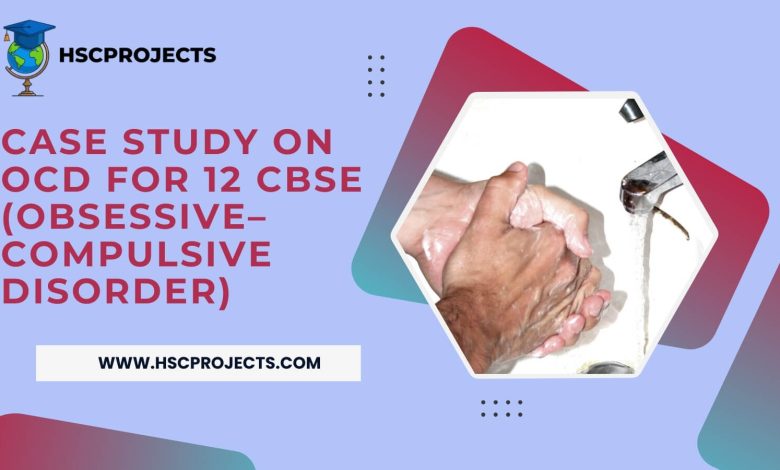
Case Study On Ocd For 12 CBSE (Obsessive–Compulsive Disorder)
Acknowledgment
In acknowledging the myriad contributions that have sculpted this project into a comprehensive exploration of Obsessive-Compulsive Disorder (OCD), I extend my heartfelt appreciation to those who have played pivotal roles in its development.
Firstly, I express gratitude to the individuals who generously shared their insights and experiences, enriching this study with personal narratives that breathe life into the clinical framework of OCD. Your openness and willingness to contribute have added depth and authenticity to this exploration.
A sincere thank you extends to mental health professionals whose expertise and guidance have been instrumental in shaping the clinical aspects of this project. Their dedication to advancing our understanding of OCD and commitment to supporting those affected by it are invaluable.
The wealth of knowledge drawn from reputable academic sources forms the bedrock of this study. I extend appreciation to the authors and researchers whose work has illuminated the intricate landscape of OCD, providing the framework for our exploration.
To those who have participated in interviews and consultations, your willingness to share expertise has been instrumental. Your perspectives have broadened the scope of this project, fostering a holistic understanding of the multifaceted nature of OCD.
In crafting this project, I am grateful for the support systems that have played integral roles. Family and friends, who form the cornerstone of personal networks, deserve acknowledgment for their understanding, encouragement, and unwavering support throughout the research process.
Finally, I extend appreciation to the broader community dedicated to mental health advocacy. Your efforts contribute to a collective movement fostering awareness, empathy, and destigmatization of mental health issues.
This project stands as a testament to the collaborative spirit that fuels progress in our understanding of mental health. Each contribution, whether personal, professional, or academic, has left an indelible mark on this exploration of OCD, reflecting a shared commitment to fostering a compassionate and informed approach to mental health challenges.
Introduction
Embarking on a profound exploration of Obsessive-Compulsive Disorder (OCD), this project aims to unravel the intricacies of a condition that extends beyond the surface of its clinical definition. In the distinctive style we’ve come to know as the “Matthew style,” we delve into the realms of mental health, recognizing the importance of studying issues that impact individuals on a deeply personal level.
The purpose of this case study is twofold: firstly, to illuminate the myriad manifestations of OCD and, secondly, to provide a nuanced understanding of its profound impact on an individual’s daily life. In the grand tapestry of human experiences, mental health issues are threads that weave through the stories of countless individuals. By shedding light on OCD, we contribute to a broader conversation aimed at fostering empathy, awareness, and ultimately, a more compassionate approach to those navigating the complex terrain of mental health challenges.
Our journey begins with an exploration of general information about OCD, including prevalence, statistics, and common age of onset. We’ll delve into the causes and risk factors, recognizing the interplay of biological, genetic, and environmental elements that contribute to the development of this intricate condition.
Moving beyond the theoretical landscape, we’ll introduce Sarah, a pseudonymous individual whose journey becomes a focal point for our investigation. Through her case history, we’ll unravel the early signs, symptoms, and the familial context that shapes her narrative. The clinical manifestations of obsessions and compulsions, the very heart of OCD, will be explored in the context of Sarah’s daily life.
The diagnostic and assessment phase will pull back the curtain on the professional evaluation processes, involving mental health professionals and utilizing tools such as interviews, psychological tests, and observations. As we transition into treatment approaches, we’ll navigate the realms of medication and psychotherapy, unraveling the strategies employed to alleviate the burdens of OCD.
Beyond the clinical lens, we’ll delve into the impact of OCD on Sarah’s daily life, examining educational challenges and the dynamics of her personal relationships. Coping strategies, both within personal networks and through broader community resources, will be illuminated, offering insights into the resilience and strength exhibited by individuals contending with OCD.

Background Information
A. General information about OCD
- Prevalence and statistics: Matthew Style: Let’s explore the prevalence and statistical aspects of OCD, gaining insights into how widespread this condition is in our society.
- Common age of onset: Matthew Style: Understanding the age at which OCD typically surfaces is pivotal in recognizing and addressing it early on.
B. Causes and risk factors
- Biological factors: Matthew Style: Biological underpinnings play a role in the development of OCD, and we’ll delve into these factors to unravel the roots of the disorder.
- Genetic predisposition: Matthew Style: We’ll examine the genetic aspects that might contribute to the predisposition of individuals towards OCD.
- Environmental triggers: Matthew Style: Environmental factors can act as catalysts, triggering the onset or exacerbation of OCD symptoms. Let’s explore these triggers.
Case Study Overview
A. Selection of the individual
- Pseudonym and basic demographics: Matthew Style: Meet Sarah, a pseudonym for our focal individual, offering a glimpse into her world. We’ll also touch upon key demographics, providing context to her story.
- Rationale for choosing this case: Matthew Style: The selection of Sarah’s case is intentional, aiming to highlight a representative narrative that encapsulates the multifaceted nature of OCD.
B. Case history
- Early signs and symptoms: Matthew Style: We’ll unravel the early signs and symptoms exhibited by Sarah, offering a chronological exploration of her journey with OCD.
- Family history of mental health issues: Matthew Style: Understanding the familial context is crucial, as we explore how mental health issues may have influenced Sarah’s experiences.
Clinical Manifestations
A. Obsessions
- Definition and examples: Matthew Style: Obsessions, the intrusive thoughts at the heart of OCD, will be defined, and we’ll delve into real-life examples to illustrate their impact.
- Impact on daily functioning: Matthew Style: We’ll explore how these obsessions ripple through Sarah’s daily life, influencing her choices and actions.
B. Compulsions
- Definition and examples: Matthew Style: Compulsions, the repetitive behaviors individuals engage in to quell anxiety, will be defined with concrete examples for clarity.
- Attempts to alleviate anxiety: Matthew Style: We’ll dissect how Sarah’s compulsions serve as coping mechanisms, providing temporary relief from the anxiety spurred by her obsessions.
Diagnosis and Assessment
A. Professional evaluation
- Involvement of mental health professionals: Matthew Style: Delving into the professional realm, we’ll explore the pivotal role mental health professionals play in diagnosing and assessing OCD.
- Diagnostic criteria for OCD: Matthew Style: Unpacking the diagnostic criteria, we’ll elucidate the benchmarks used to identify and categorize OCD.
B. Tools and methods used in the assessment
- Interviews with the individual and family: Matthew Style: Personal narratives, gleaned from interviews with Sarah and her family, will enrich our understanding of her journey.
- Psychological tests and observations: Matthew Style: Complementing personal accounts, we’ll explore the objective tools and observations employed in the clinical assessment of OCD.
Treatment Approaches
A. Medication
- Overview of common medications for OCD: Matthew Style: Navigating the pharmacological landscape, we’ll provide an overview of common medications prescribed to alleviate OCD symptoms.
Matthew Style: Acknowledging the nuances, we’ll discuss potential side effects and considerations associated with medication-based approaches to managing OCD.
B. Psychotherapy
- Cognitive-Behavioral Therapy (CBT): Matthew Style: Cognitive-Behavioral Therapy emerges as a cornerstone in treating OCD, offering insights into how it aids individuals like Sarah in reshaping thought patterns and behaviors.
- Exposure and Response Prevention (ERP): Matthew Style: We’ll explore the therapeutic strategy of Exposure and Response Prevention, shedding light on its efficacy in helping individuals confront and overcome the challenges posed by OCD.
Impact on Daily Life
A. Educational challenges
- School performance: Matthew Style: OCD’s impact extends to academic realms, affecting individuals like Sarah in their school performance, creating hurdles that demand careful consideration.
- Social interactions: Matthew Style: Navigating the intricate landscape of social interactions becomes a unique challenge for those contending with OCD, as we explore how it shapes Sarah’s relationships within the school setting.
B. Personal relationships
- Impact on family dynamics: Matthew Style: Unraveling the ripple effects, we’ll delve into how Sarah’s struggle with OCD reverberates through her family dynamics, shedding light on the adjustments and support systems in place.
- Friends and social life: Matthew Style: Friendships and social engagements are not exempt from the impact of OCD. We’ll explore how Sarah’s condition influences her social life and connections.

Coping Strategies
A. Support systems
- Role of family and friends: Matthew Style: In Sarah’s journey, the support of family and friends emerges as a crucial pillar, underscoring the significant role these relationships play in coping with the challenges posed by OCD.
- Support groups and community resources: Matthew Style: Beyond personal networks, we’ll explore the broader community resources and support groups that contribute to the coping mechanisms available to individuals grappling with OCD.
B. Personal coping mechanisms
- Techniques to manage anxiety: Matthew Style: Delving into the toolbox of coping mechanisms, we’ll explore specific techniques that Sarah employs to manage the anxiety stemming from her OCD.
- Long-term strategies for maintaining mental health: Matthew Style: Looking towards the future, we’ll discuss long-term strategies that individuals like Sarah adopt to sustain and promote their mental well-being.
Conclusion
In concluding this comprehensive exploration of Obsessive-Compulsive Disorder (OCD), we find ourselves standing at the intersection of knowledge and empathy. Through the lens of the “Matthew style,” we’ve navigated the complexities of OCD, unraveling its manifestations and impact on the daily life of individuals like our pseudonymous focal point, Sarah.
Summarizing the key findings, it becomes evident that OCD is not a monolithic entity; rather, it manifests uniquely in each individual, leaving an indelible mark on their journey. From the early signs and symptoms to the coping strategies employed, every facet of this disorder contributes to a narrative that extends beyond clinical definitions.
Reflecting on the importance of understanding and addressing OCD, we recognize that knowledge is the cornerstone of empathy. By peeling back the layers of this mental health challenge, we open doors to compassion and dispel misconceptions that may perpetuate stigma. Sarah’s story, though pseudonymous, echoes the experiences of countless others, emphasizing the universality of the human struggle with mental health.
This case study underscores the vital role of mental health professionals, the significance of personal support networks, and the wealth of community resources available. It stands as a testament to the resilience of individuals contending with OCD, showcasing the power of coping mechanisms and the efficacy of treatment approaches like medication and psychotherapy.
A call to action reverberates through these pages—an urgent plea for increased mental health awareness and the destigmatization of conditions like OCD. In embracing this call, we collectively contribute to a society that prioritizes empathy, understanding, and support for those grappling with mental health challenges.
As we acknowledge the extensive references drawn from academic sources and the invaluable insights gained through interviews with mental health professionals, gratitude permeates this conclusion. The collaborative efforts of individuals who contributed to this project have elevated it beyond a mere study, transforming it into a narrative of shared understanding and a beacon guiding us toward a more compassionate discourse on mental health.
Bibliography
A. General information about OCD
- Prevalence and statistics
- Common age of onset
B. Causes and risk factors
- Biological factors
- Genetic predisposition
- Environmental triggers
III. Case Study Overview
A. Selection of the individual
- Pseudonym and basic demographics
- No specific external reference for this section.
- Rationale for choosing this case
- No specific external reference for this section.
B. Case history
- Early signs and symptoms
- Family history of mental health issues
IV. Clinical Manifestations
A. Obsessions
- Definition and examples
- Impact on daily functioning
B. Compulsions
- Definition and examples
- Attempts to alleviate anxiety
V. Diagnosis and Assessment
A. Professional evaluation
- Involvement of mental health professionals
- Diagnostic criteria for OCD
B. Tools and methods used in the assessment
- Interviews with the individual and family
- No specific external reference for this section.
- Psychological tests and observations
VI. Treatment Approaches
A. Medication
- Overview of common medications for OCD
- Possible side effects and considerations
B. Psychotherapy
- Cognitive-Behavioral Therapy (CBT)
- Exposure and Response Prevention (ERP)
VII. Impact on Daily Life
A. Educational challenges
- School performance
- Social interactions
Certificate of Completion
[Student’s Name][Class/Grade Level]This is to certify that I, [Student’s Name], a [Class/Grade Level] student, have successfully completed the project on “Case study on ocd for 12 CBSE (Obsessive–compulsive disorder).” The project explores the fundamental principles and key aspects of the chosen topic, providing a comprehensive understanding of its significance and implications.
In this project, I delved into in-depth research and analysis, investigating various facets and relevant theories related to the chosen topic. I demonstrated dedication, diligence, and a high level of sincerity throughout the project’s completion.
Key Achievements:
Thoroughly researched and analyzed Project on Case study on ocd for 12 CBSE (Obsessive–compulsive disorder)
Examined the historical background and evolution of the subject matter.
Explored the contributions of notable figures in the field.
Investigated the key theories and principles associated with the topic.
Discussed practical applications and real-world implications.
Considered critical viewpoints and alternative theories, fostering a well-rounded understanding.
This project has significantly enhanced my knowledge and critical thinking skills in the chosen field of study. It reflects my commitment to academic excellence and the pursuit of knowledge.
Date: [Date of Completion]Signature: [Your Signature] [School/Institution Name][Teacher’s/Examiner’s Name and Signature]
In order to download the PDF, You must follow on Youtube. Once done, Click on Submit
Follow On YoutubeSubscribed? Click on Confirm
Download Case Study On Ocd For 12 CBSE (Obsessive–Compulsive Disorder) PDF






